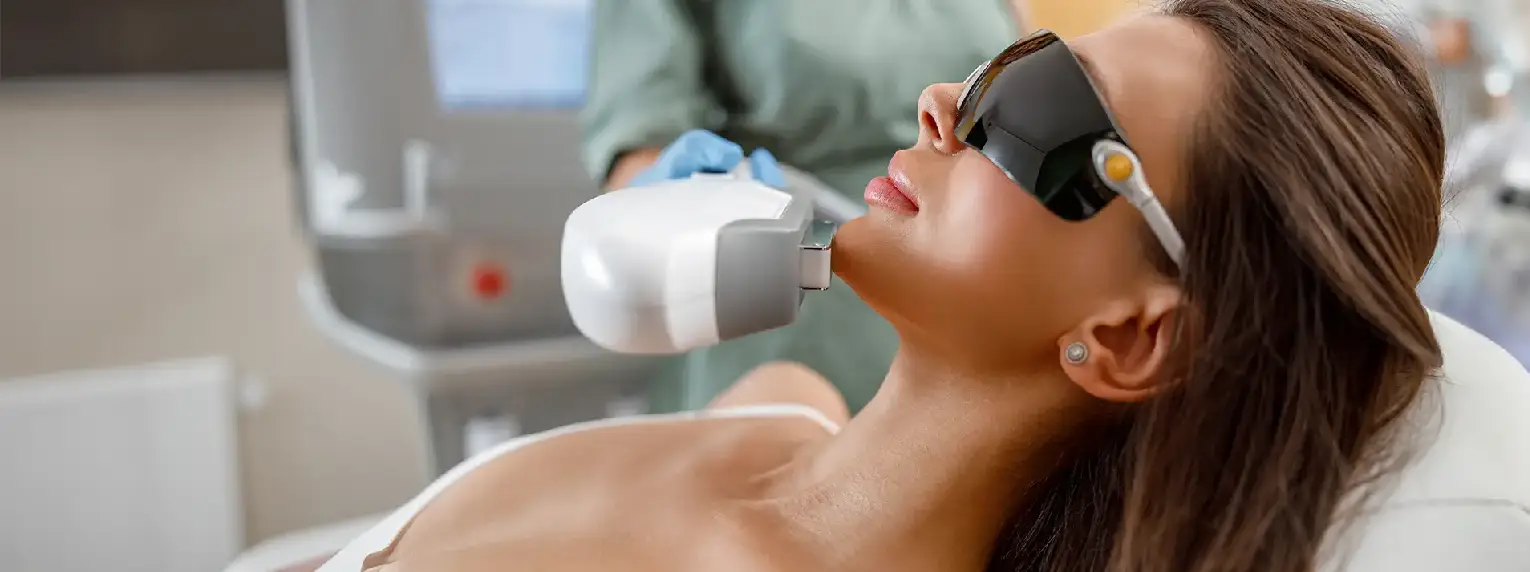Cosmetic Surgery
Cosmetic Procedure
Dentistry
Non Surgical Body Contour
Laser hair removal is a dermatological procedure that uses concentrated light energy to target and destroy the hair follicles, which are responsible for hair growth. The laser emits a specific wavelength of light that is absorbed by the pigment (melanin) in the hair, which then gets converted into heat. This heat damages the hair follicle and inhibits its ability to grow new hair.
Key Features of Laser Hair Removal:
● Long-Lasting Results: Laser hair removal provides permanent hair reduction with
just a few sessions, offering long-lasting results.
● Precision: The laser targets only the hair follicle, leaving the surrounding skin
unharmed, ensuring safe and effective treatment.
● Minimal Discomfort: Most patients report minimal discomfort during the procedure, often describing the sensation as a mild pinprick or warmth.
● Versatile Treatment: Laser hair removal can be used on almost all areas of the body, including the face, legs, arms, bikini line, and back.
Benefits of Laser Hair Removal
1. Permanent Hair Reduction: One of the main reasons people opt for laser hair removal is its ability to offer long-lasting results. While it might take multiple sessions for full results, many patients see permanent reduction in hair growth after completing their treatments.
2. Precision: Laser hair removal targets hair follicles individually, meaning it can remove hair with precision while leaving the surrounding skin unharmed. It is highly effective in treating dark hair and light skin but has also shown success in various hair and skin types with newer technologies.
3. Faster than Traditional Hair Removal Methods: Unlike traditional methods like waxing or shaving, which can be time-consuming, laser hair removal treats multiple hairs at once, making it a quick procedure for larger areas of the body (such as the back or legs).
4. Cost-Effective Over Time: While laser hair removal may involve an upfront cost, it can save you money in the long run by eliminating the need for continuous waxing, shaving, or purchasing hair removal products.
5. Minimal Downtime: There is no downtime required after a laser hair removal session. You can return to your normal routine right away, with only slight redness or irritation, which typically disappears within a few hours.
6. Safe and FDA-Approved: Modern lasers used in dermatology are FDA-approved for hair removal, ensuring that the treatments are safe and effective when performed by certified professionals.
How Laser Hair Removal Works
1. Consultation: Before undergoing laser hair removal, patients must have an initial
consultation with a dermatologist or trained technician to assess their skin type, hair
color, and treatment area. This ensures the appropriate laser technology is chosen for the best results.
2. Treatment Process: During the procedure, a laser device is passed over the treatment area. The device emits a concentrated beam of light, which is absorbed by the pigment in the hair follicles. The energy from the laser damages the follicle, effectively reducing future hair growth. The procedure may take anywhere from a few minutes for small areas (such as the upper lip) to an hour for larger areas (such as the back or legs).
3. Post–Treatment Care: After the session, patients may experience mild redness or
swelling, similar to a mild sunburn. It is important to avoid direct sun exposure and follow the aftercare instructions provided by the dermatologist to minimize any potential side effects.
4. Multiple Sessions: Laser hair removal typically requires multiple sessions (usually 4-6 sessions) to achieve optimal results. Since hair grows in different cycles, multiple treatments are necessary to target all hair follicles in the active growth phase.
Types of Lasers Used in Hair Removal
1. Alexandrite Laser: One of the most commonly used lasers for hair removal, the
alexandrite laser is suitable for individuals with light to olive skin and works well on
dark hair. It offers fast treatment sessions and is highly effective for larger areas like the legs or back.
2. Diode Laser: The diode laser is effective for treating both light and dark skin tones and is especially useful for thicker hair. It is often used for facial hair removal or sensitive areas like the bikini line.
3. Nd:YAG Laser: The Nd:YAG laser is designed for darker skin tones and is the safest choice for individuals with darker complexions. It is effective for larger areas of the body and can treat coarse hair with minimal risk of pigmentation changes.
4. Ruby Laser: The ruby laser is one of the oldest lasers used for hair removal and is typically best suited for light skin and dark hair. It is less commonly used today, as
newer lasers are more efficient.


